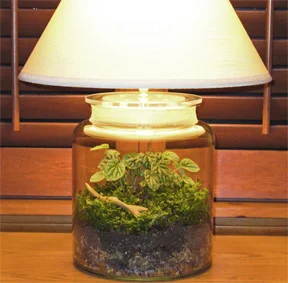A Terrarium "How To"
For as long as I can remember I have always had a fascination with terrariums. I am starting to see them more and more and since I am so "over" silk arrangements, this is a great alternative, it's "live", "green" and super easy to keep alive. I love the use of apothecary jars by SmithandHawken.
Wow, how beautiful would these ornaments from floragrubb be on a white Christmas tree?
This is just pure and simple sophistication by gettyimages
How clever is this by moontreehandworks?
My favorite look is when terrariums are grouped together
One of the great things about terrariums is that they are easy and inexpensive to do yourself. They also make excellent gifts! Thanks to Kerry Michaels about.com here is a wonderful how to:
HOW TO MAKE TERRARIUMS
You can make a terrarium in less than an hour. Making terrariums can be quick, easy and doesn't have to be expensive. To save money on your terrariums, shop discount stores, flea markets or consignment shops, where you can find really cheap yet great looking glass containers, jars or even goldfish bowls. The terrarium plants you’ll use are generally small houseplants, which often only cost a couple of bucks each, so the whole project, depending on the size of your jars, can be made for well under $20. Terrariums also make wonderful and impressive gifts, even for people who consider themselves plant-challenged
WHAT YOU NEED FOR YOUR TERRARIUM
Glass containers with or without tops
Gravel, sea glass or beach stones
Activated charcoal (found at a nursery or pet supply store)
Terrarium plants
Sterile potting mix
Moss (optional)
Decorative elements (optional)
CHOOSING YOUR TERRARIUM
You can really use anything for a terrarium, as long as it is glass. You can even use heavy plastic, but I prefer the look and feel of glass.
For your terrarium, look for a jar or container with a wide mouth. While it is possible to use something with a small opening, it is much easier to add plants if your container has a wide mouth. Also, keep in mind that ideally you don’t want your plants touching the sides of your jar; so the wider the bowl the more plants and soil you’ll be able to fit.
Also, keep in mind, if you use a large container, you will have a greater choice of types and size plants you can use as well as the option of fitting in decorative elements, such as shells, figurines or ornaments.
I found these jars that are perfect for terrariums at a discount store - all cost $7.00 or less. I chose them because I wanted to make an arrangement of three terrariums that would sit on a corner table.
CHOOSING TERRARIUM PLANTS
When choosing terrarium plants, make sure they are small enough to fit in your terrarium, once they are planted, preferably without touching the sides. You'll also want to buy terrarium plants that don’t mind a humid environment. This leaves out most succulents and cactus.
However, if you have your heart set on succulents, you can make beautiful terrariums with these plants, but you will want to make a topless terrarium and add clean, course sand to your potting mix.
When considering terrarium plants, look for plants that like low to medium light. I also try to get a mix of sizes, leaf textures and leaf colors.
Here's a list of possible terrarium plants. Lots of others will work, but these are some of my favorites.
Prayer Plant
Club moss
Creeping fig
ADDING DRAINAGE LAYERS TO YOUR TERRARIUM
Your terrarium will not have drainage holes in the bottom so you’ll want to create a place for extra water to go that keeps it away from your plants’ roots. I often put a layer of sheet moss in the bottom of my terrarium to soak up extra water. I also like the way it looks.
If you don't have moss, you can also start a layer of stones. Put at least 2” layer of stones in the bottom (you do have some flexibility with this if your container is shallow).
Next, using a large a spoon, add an ¼ to ½ inch layer of activated charcoal on top of the stones. The purpose of this is to help drainage and control any odor that might occur
ADD MOSS THEN POTTING MIX TO YOUR TERRARIUM
The next step is to add moss on top of the stones and charcoal. This is to keep your next layer, potting soil, from mixing in with the charcoal and stones. This is an aesthetic decision so this step is optional. I think it’s worth doing, because it can add visual interest to your terrarium.With a large spoon or small shovel, add sterile soil-less potting mix on top of your moss or if you aren't using moss, put the potting mix right on top of your charcoal. Add as much potting mix as you can - at least a couple of inches. You will want to make sure your plants will fit into your terrarium with the top on, so you might have to hold your plants up to measure as you add soil.At this point it’s important to think about the design of your terrarium. Will the terrarium have a back and a front? If so, you probably want to put your tallest plant in back, or in the middle. You can also contour your soil so that it mounds and sinks to create interest.
PREPARING YOUR TERRARIUM PLANTS
Remove your terrarium plants from their pots. You may find that they are root bound in which case you will want to tease the roots apart, even cutting some off. By cutting off some of the roots, called root pruning, you will also retard your plant’s growth, which is usually a good thing when growing plants in the confines of a terrarium. You'll also want to take off any excess soil as well.Some plants can be separated by gently pulling them apart. If you’re not sure, look at the base of the plant; there may be several small plants grouped tightly together even though it just looks like one plant. This can come in handy if the plant looks too big once you've tried it out in your terrarium.
PLANTING YOUR TERRARIUM
Using a large spoon, or your fingers, dig a hole in the potting mix.Place your terrarium plant in the hole and gently pat the soil around it. If your terrarium has a narrow neck that you can’t fit your hand into, you can use cooking chopsticks, tongs or long tweezers to place your plants and pat them in.You do want to make sure that there are no air pockets between the roots of your terrarium plants and the soil.A good trick, which I learned from Tovah Martin's fabulous book, The New Terrarium, she suggests that you put a cork on the end of a skewer or chopstick to tamp down soil, particularly for a terrarium with a small opening.
WATERING YOUR TERRARIUM
Using a spray bottle or watering can with a rose attachment on the spout, water your terrarium. You don’t want it to be soaking wet, just damp. You can also use the spray bottle to clean off any dirt that has clung to the glass sides of your container, which you can then wipe clean with newspaper or newsprint.Never use glass cleaner on the inside of a planted terrarium, as it could make your plants sick
CARING FOR YOUR TERRARIUM
Caring for your terrarium is easy. Check every couple of weeks to see if your terrarium needs water. Feel the soil to see if it is dry and add water if it is.If your terrarium is closed, take off the top at least once a month to air it out. If you see lots of condensation or have added too much water, leave the top off until it has had a chance to dry out.Pull off any leaves that show signs of yellowing or damage and prune plants if they grow too large.Don’t fertilize your terrarium because you don’t want to encourage growth.
Pretty simple huh?















